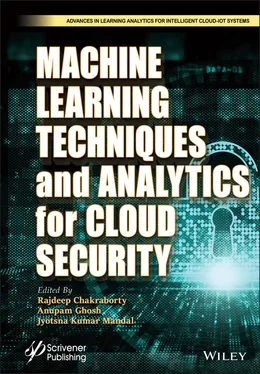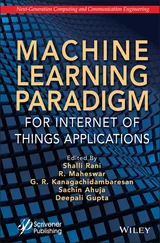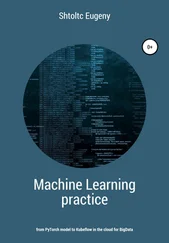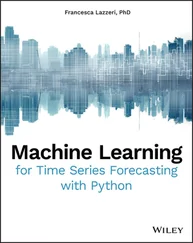Machine Learning Techniques and Analytics for Cloud Security
Здесь есть возможность читать онлайн «Machine Learning Techniques and Analytics for Cloud Security» — ознакомительный отрывок электронной книги совершенно бесплатно, а после прочтения отрывка купить полную версию. В некоторых случаях можно слушать аудио, скачать через торрент в формате fb2 и присутствует краткое содержание. Жанр: unrecognised, на английском языке. Описание произведения, (предисловие) а так же отзывы посетителей доступны на портале библиотеки ЛибКат.
- Название:Machine Learning Techniques and Analytics for Cloud Security
- Автор:
- Жанр:
- Год:неизвестен
- ISBN:нет данных
- Рейтинг книги:3 / 5. Голосов: 1
-
Избранное:Добавить в избранное
- Отзывы:
-
Ваша оценка:
- 60
- 1
- 2
- 3
- 4
- 5
Machine Learning Techniques and Analytics for Cloud Security: краткое содержание, описание и аннотация
Предлагаем к чтению аннотацию, описание, краткое содержание или предисловие (зависит от того, что написал сам автор книги «Machine Learning Techniques and Analytics for Cloud Security»). Если вы не нашли необходимую информацию о книге — напишите в комментариях, мы постараемся отыскать её.
This book covers new methods, surveys, case studies, and policy with almost all machine learning techniques and analytics for cloud security solutions
Audience The aim of Machine Learning Techniques and Analytics for Cloud Security
Machine Learning Techniques and Analytics for Cloud Security — читать онлайн ознакомительный отрывок
Ниже представлен текст книги, разбитый по страницам. Система сохранения места последней прочитанной страницы, позволяет с удобством читать онлайн бесплатно книгу «Machine Learning Techniques and Analytics for Cloud Security», без необходимости каждый раз заново искать на чём Вы остановились. Поставьте закладку, и сможете в любой момент перейти на страницу, на которой закончили чтение.
Интервал:
Закладка:
15. Hybrid Cloud Opportunity, https://www.thehindu.com/business/Industry/india-is-key-toibms-pursuit-of-a1-trillion-hybrid-cloud-opportunity/article33201906.ece. Accessed on 12th October, 2020.
16. Aryotejo, G., Kristiyanto, D.Y., Mufadhol, Hybrid cloud: bridging of private and public cloud computing. IOP Conf. Series: J. Physics: Conf. Ser ., 1025, 012091, 2018.
17. Hybrid Cloud Providers, https://www.loomsystems.com/blog/hybrid-cloud-providers, Accessed on 10th November, 2020.
18. Top 5 Cloud Providers, https://www.cloudmanagementinsider.com/top-five-cloud-computing-news-june-2020, Accessed on 20th November, 2020.
19. SaaS-Cloud-Providers, https://www.zdnet.com/article/the-top-cloud-providers-of-2020-awsmicrosoft-azure-google-cloud-hybrid-saas. Accessed on 20th November, 2020.
20. Kumar, S., Kumar, S., Bajwa, M.S., Sharma, H., A Comparative Study of Various Cloud Service Platforms. J. Adv. Database Manage. Syst ., 6, 1, pp. 7–12, 2020.
21. Islam, N. and Rehman, A., A comparative study of major service providers for cloud computing, in the Proceedings of 1st International Conference on Information and Communication Technology Trends, at Karachi Pakistan, 2014.
22. Kimmy, A Comparative Study Of Clouds In Cloud Computing. Int. J. Comput. Sci. Eng. Technol. (IJCSET) , 4, pp. 843–849 2013.
23. Sharma, A. and Garg, S., Comparative Study of Cloud Computing Solutions. IJCST , 6, 4, pp. 231–233, Oct - Dec 2015.
24. Data Protection in Cloud, https://www.nutanix.com/theforecastbynutanix/technology/protecting-data-when-running-ai-in-the-cloud, Accessed on 10th December, 2020.
25. AI and Hybrid Cloud, https://www.hcltech.com/blogs/growing-bond-between-ai-hybridcloud, Accessed on 5th December, 2020.
26. Pervasive Encryption, https://www.ibm.com/support/z-content-solutions/pervasive-encryption/, Accessed on 6th December, 2020.
27. Nutanix, https://www.nutanix.com/, Accessed on 10th December, 2020.
28. Quantifi, https://www.quantifisolutions.com/overview, Accessed on 10th December, 2020.
29. IBM Watson, https://www.ibm.com/in-en/watson, Accessed on 7th December, 2020.
30. Watson Blog, https://www.ibm.com/blogs/watson/2019/09/gartner-names-ibm-a-leader-in-2019-magic-quadrant-for-insight-engines/, Accessed on 7th December, 613, pp. 480–489, 2020.
31. Hybrid cloud in Education, https://www.intel.fr/content/dam/www/public/us/en/documents/education/hybrid-cloud-in-education.pdf, Accessed on 10 thDecember, 2020.
32. Dhinakaran, K., Kirtana, R., Gayathri, K., Devisri, R., Enhance hybrid cloud security using Vulnerability Management. Adv. Intell. Syst. Comput ., 613, pp. 480–489, December 2018.
33. Vaishnnave, M.P., Suganya Devi, K., Srinivasan, P., A Survey on Cloud Computing and Hybrid Cloud. Int. J. Appl. Eng. Res ., 2019.
34. Cearley, W. and Hilgendorf, K., Cloud Computing Innovation Key Initiative Overview, Gartner Research Database, Volume 15 pp. 45–52, 2014.
1 *Corresponding author: moudeb@gmail.com
2 †Corresponding author: abantika_choudhury@rediffmail.com
2
Recognition of Differentially Expressed Glycan Structure of H1N1 Virus Using Unsupervised Learning Framework
Shillpi Mishrra
Department of Computer Science and Engineering, Techno India University, Kolkata, India
Abstract
Influenza A (H1N1) virus created a pandemic situation around the world from 1918 to 1919. More than 10,000 cases have been reported to the World Health Organization (WHO). It affects species and sometimes in humans. Binding of hemagglutinin and some types of glycan receptors is the major ingredients for virus infections. In this work, we take both H1N1 infected human and non-infected human glycan datasets and identify differentially expressed glycans. In this work, we narrate a computational frame work using the cluster algorithm, namely, k-means, hierarchical, and fuzzy c-means. The entire methodology has been demonstrated on glycan datasets and recognizes the set of glycans that are significantly expressed from normal state to infected state. The result of the methodology has been validated using t-test and F-score.
Keywords :Glycan receptors, differentially expressed glycan, clustering, k-means, fuzzy, F-score, glycan cloud
2.1 Introduction
Influenza A is a widespread infectious disease caused by the influenza virus that can easily spread from one person to another by coughing, sneezing, etc. This virus infects hosts like humans, sea-mammals, and swine. The first reported pandemic from 1918 to 1919 and the other two pandemics occurred in the 20th century [1–3]. Every year, 250,000 to 500,000 deaths occurred worldwide for this virus. In the past few years, there are lots of disasters that occurred, for example, pandemic named “Spanish Flu” caused the global death of 60 to 100 million people in the 1918. In 2009, scientists recognized a particular strain of influenza A virus which is known as H1N1 [4, 5]. H1N1 is normally found in swine. For this reason, it is also called “Swine Flu” or “Pig Flu” or “Swine influenza viruses (SIVs)”. It is a human respiratory infection caused by the H1N1 influenza that is basically started in pigs and contains RNA virus with a segmented genome. It is also called orthomyxovirus because it contains haemagglutinin and neuraminidase glycoproteins. Transmission of swine flu to humans is rare. But, swine flu can be transmitted to humans via contact with infected swine or environments contaminated. Once a human gets infected, humans can then spread this virus to other humans, and in the same way, swine flu is spread (i.e., cough or sneezing). It is a mystery that when and where pandemic reassortments will happen. Lots of reports suggest that this type of reassortments is very frequent between human viruses [6]. Influenza has been found very frequently with co-infections and reassortment of swine and human. Cell surface oligosaccharide receptors of the swine windpipe present a NeuAcalpha2, 6 Gal linkages, and preferred by human viruses. Some glycans with sialic acid α2,6-linked (SA2,6Gal) are detected more immense in the upper airways than the lower airways in the human body [7–10]. According to the “central dogma” biological concept, double-stranded DNA is simulated into RNA and this RNA carries some instructions for making proteins that mean DNA to RNA to protein. Glycosylation and phosphorylation are the post-translational modifications techniques that are required to estimate for the accurate regulation that is required by the living system. Every cell is wrapper up with a coat (solid) of glycans to create interface of molecular between the cells and environment of cells. Glycosylation is basically enzymatic techniques where this technique is the key factors to establish the connection of carbohydrates to proteins through nitrogen and oxygen links. Whole process happens with the Endoplasmic Reticulum (cell) that arranged with different types of glycol-sialyltransferases and glycosidases [9–16]. The immune system is an important component to keep up a hygenic and well balanced system that is very organized by a sequence of stimulatory and restrictive ways. If whole system is broken down, then autoimmunity can occur for loss of immune tolerance and it can also effect in unusual costimulatory signals. The proper growth and function of the immune system confide pair on the glycan-structures (expression) and glycan-binding proteins, and the association between them. Innate immune is responsible to identify the molecular “patterns” that basically find on microbes. Microbes are responsible to bind by pattern recognition receptors that is one kind of protein to identify molecules in pathogen, C-type (calcium-dependent), lectins (types are Dectin-1 and DC-SIGN), and mannose-binding lectin. The glycans that are found on sensors of innate immune system can be classified by two effects they are “direct” and “indirect” effects [11–15] and these are playing important role in influencing microbe-host interactions and T and B cell identification. Glycan-binding proteins known as GBP are very important within the immune systems that are basically the lectins and the sialic acid-binding immunoglobulin (Siglecs). Within the lectin family, lots of pattern recognition receptors are present like as DC-SIGN and Dectin-1 and the selectins that are L-selectin, E-selectin, and P-selectin. For leukocyte function, lectins are very complex to communicate with the glycans of cell surface that are basically sialyl-LewisX and 6′-sulfo-sialyl-LewisX. To bind the glycoprotein as counter receptors, L-lectins are expressed by leukocytes on endothelial cells for directing naive T cells. In contrast, on endothelial cells, E-lectins and P-lectins are both expressed as a impact of inflammation. The selectins and their glycan ligands interactions facilitate adherence of leukocytes along the endothelium and allowing the cells to migrate into tissues in response to chemokines that are bound to glycol-saminoglycans [12–18]. This way, communication of glycans and selectins are responsible for leukocyte function by arranging restricted to the ideal anatomic field. Another group of glycan-binding molecules are siglecs. But siglecs’ function is perfectly separate from lectins (c-type) and galectins. Siglecs are also receptors of cell surface for recognizing sialic acids and high-ranking vertebrates. It has also cytoplasmic tails that holds more than immune-receptor inhibitory motif sequences (tyrosine-based). Glycans holds different types of effects (indirect) on lymphocyte function [12–19]. To reduce the N-glycans’ complexity on T-cell receptors, these effects are resulted to raised T-cell receptors clustering and signaling at antigen density (lower). In the T-cell receptors signaling process, galectin is not directly engaged and Mgat5 enzyme plays an important role to contribute of N-glycan complexity that increase autoimmune disorders of H1N1 disease and had raised sensibility to empirical autoimmune encephalitis. Similarly, decease of N-glycan complexity on glycoproteins of the cell surface is changed the signaling via lectins and cytokine receptors [17–22].
Читать дальшеИнтервал:
Закладка:
Похожие книги на «Machine Learning Techniques and Analytics for Cloud Security»
Представляем Вашему вниманию похожие книги на «Machine Learning Techniques and Analytics for Cloud Security» списком для выбора. Мы отобрали схожую по названию и смыслу литературу в надежде предоставить читателям больше вариантов отыскать новые, интересные, ещё непрочитанные произведения.
Обсуждение, отзывы о книге «Machine Learning Techniques and Analytics for Cloud Security» и просто собственные мнения читателей. Оставьте ваши комментарии, напишите, что Вы думаете о произведении, его смысле или главных героях. Укажите что конкретно понравилось, а что нет, и почему Вы так считаете.












